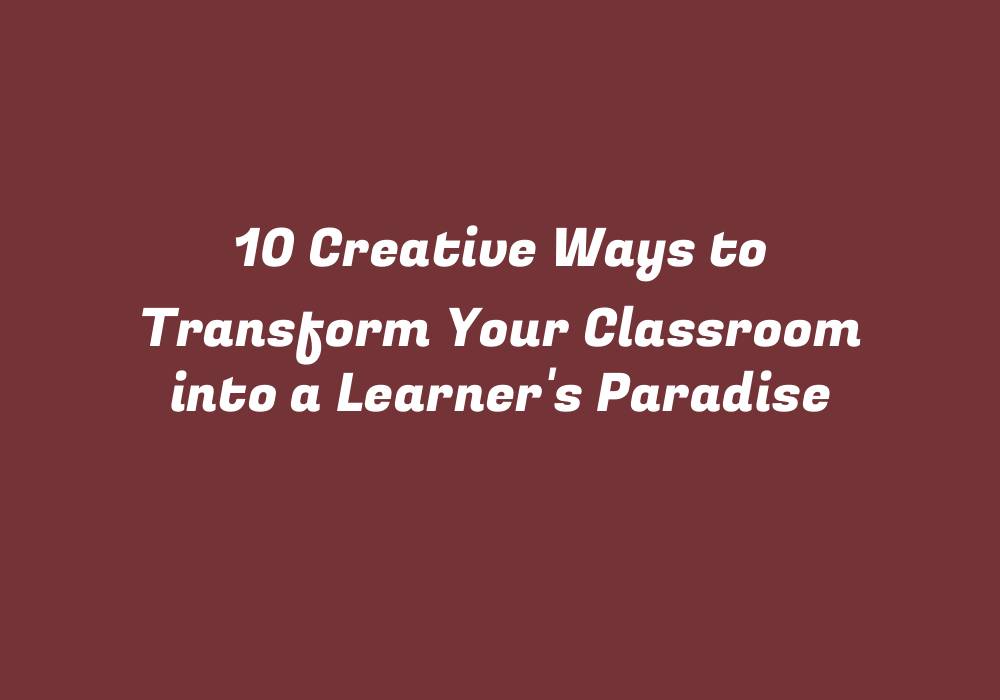Transforming Your Classroom into a Learner’s Paradise
Creativity is not just for artists or writers; it can be applied to all aspects of life, including education. A classroom environment can either foster learning and growth or stifle creativity. As educators and teachers, we have the unique opportunity to shape the atmosphere in which our students learn and develop their skills. In this article, we will explore ten creative ways to transform your classroom into a paradise for learning.
1. Encourage Collaboration
Group projects have been used since time immemorial in educational settings, but sometimes they can become monotonous and lack creativity. To encourage collaborative learning in your classroom, consider introducing activities that require students to work together on unique tasks or challenges. For example, you could set up a treasure hunt where groups need to solve clues or puzzles before they find their next location. This approach not only fosters teamwork but also enhances problem-solving and critical thinking skills.
2. Embrace Technology
Incorporating technology into your teaching methods can make learning more engaging and relevant for students. Utilize interactive whiteboards or projectors to showcase digital resources, videos, or presentations related to the lesson. Online tools such as Kahoot! and Quizizz can facilitate quizzes and games to enhance student participation and understanding of concepts. Moreover, technology opens up new opportunities for remote learning, allowing you to connect with students and parents outside traditional classroom settings.
3. Create a Dynamic Learning Space
The physical layout of your classroom can have a significant impact on the atmosphere and student engagement. Instead of sticking to traditional desks arranged in straight rows, experiment with different seating arrangements like group tables or bean bags. This allows for more informal interactions among students and fosters collaboration. You could also consider utilizing colorful posters, wall art, and other visual aids that reflect the lesson’s theme. This creates an environment that encourages learning and creativity.
4. Embrace Student-led Learning
Give your students the opportunity to take charge of their education by encouraging them to explore topics they are interested in. Allow them to select projects related to these interests or create group presentations around specific subjects. This approach not only fosters self-motivation but also develops their ability to manage time and resources effectively.
5. Introduce Flexible Schedules
Rigid timetables may limit the creativity of both teachers and students by restricting flexibility in lesson planning or execution. Instead, consider introducing flexible schedules that allow for more spontaneous learning experiences. This can include incorporating creative breaks during class or integrating new topics based on student interests or feedback.
6. Experiment with Learning Styles
Every student learns differently, and it is essential to incorporate a variety of teaching methods that cater to different learning styles. For example, you could use visual aids for visual learners, audio recordings or podcasts for auditory learners, or create hands-on activities for kinesthetic learners. By doing so, your classroom will be more inclusive and supportive for all students.
7. Encourage Critical Thinking
To transform your classroom into a learner’s paradise, it is crucial to encourage critical thinking among students. Engage them in discussions where they can challenge ideas, analyze arguments, and come up with creative solutions to problems. This can be done through debates, group projects, or even role-playing activities.
8. Promote Positive Reinforcement
Students thrive in an environment where their efforts are acknowledged and appreciated. Instead of focusing solely on academic performance, encourage your students to take risks, try new approaches, and express themselves creatively without fear of judgment. Praise them for their hard work and efforts, and they will be more motivated to continue learning.
9. Foster a Safe Environment
Creating an environment that allows students to feel safe and comfortable taking risks is key to nurturing creativity and promoting growth. Encourage open communication, listen attentively to their concerns or feedback, and create opportunities for them to share their thoughts and experiences. This will foster a sense of community among the students and contribute to their overall learning experience.
10. Embrace Continuous Improvement
Transforming your classroom into a paradise for learning is an ongoing process that requires constant reflection, adaptation, and growth. Be open to new ideas and approaches, gather feedback from both students and colleagues, and continuously evaluate the effectiveness of your teaching methods. This will ensure that your classroom remains dynamic, engaging, and conducive to creativity.
In conclusion, transforming your classroom into a paradise for learning requires creativity, adaptability, and a willingness to challenge traditional educational practices. By embracing collaboration, technology, dynamic spaces, student-led learning, flexible schedules, diverse teaching methods, critical thinking, positive reinforcement, safety, and continuous improvement, you can create an environment that fosters creativity and supports the growth of your students.
